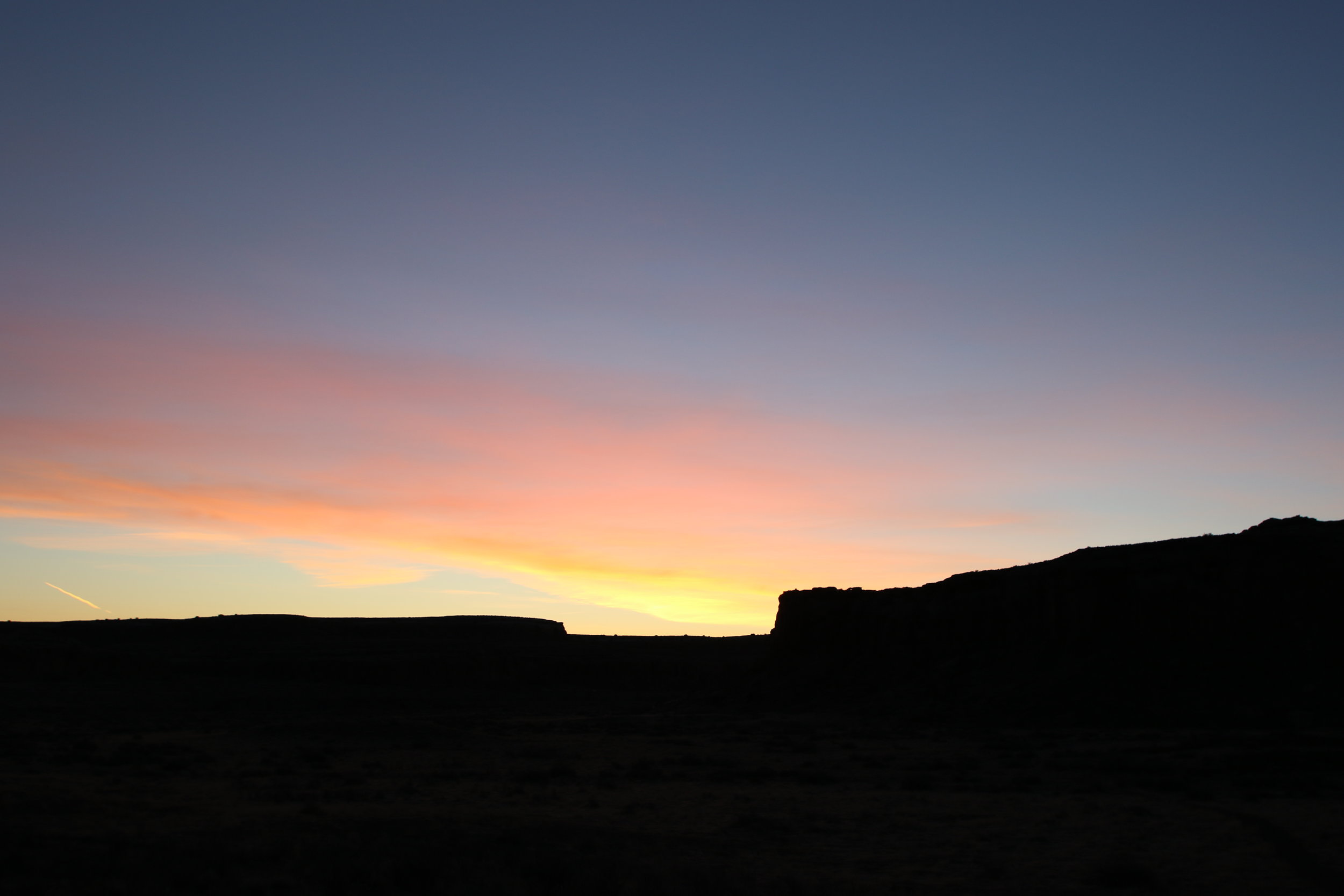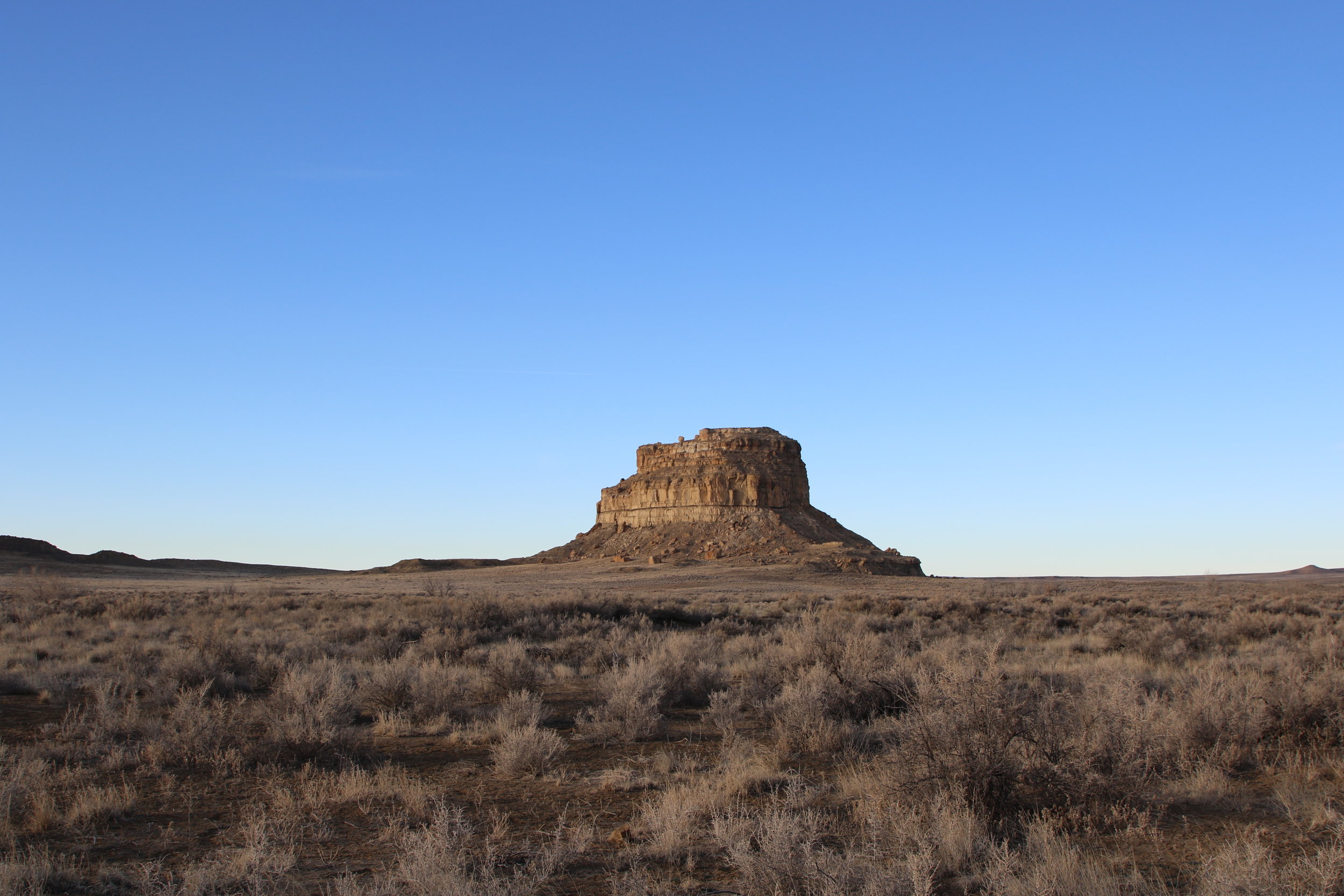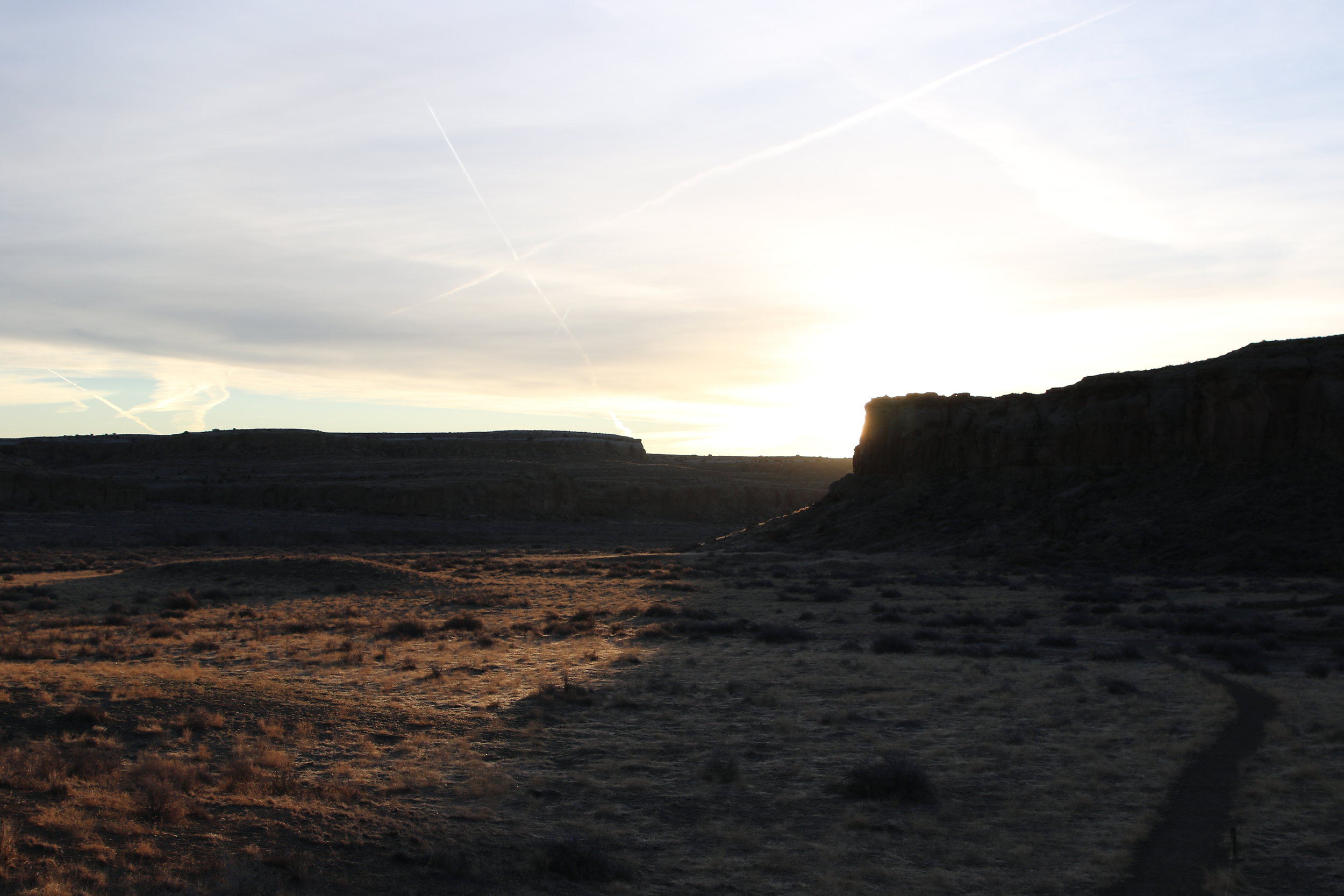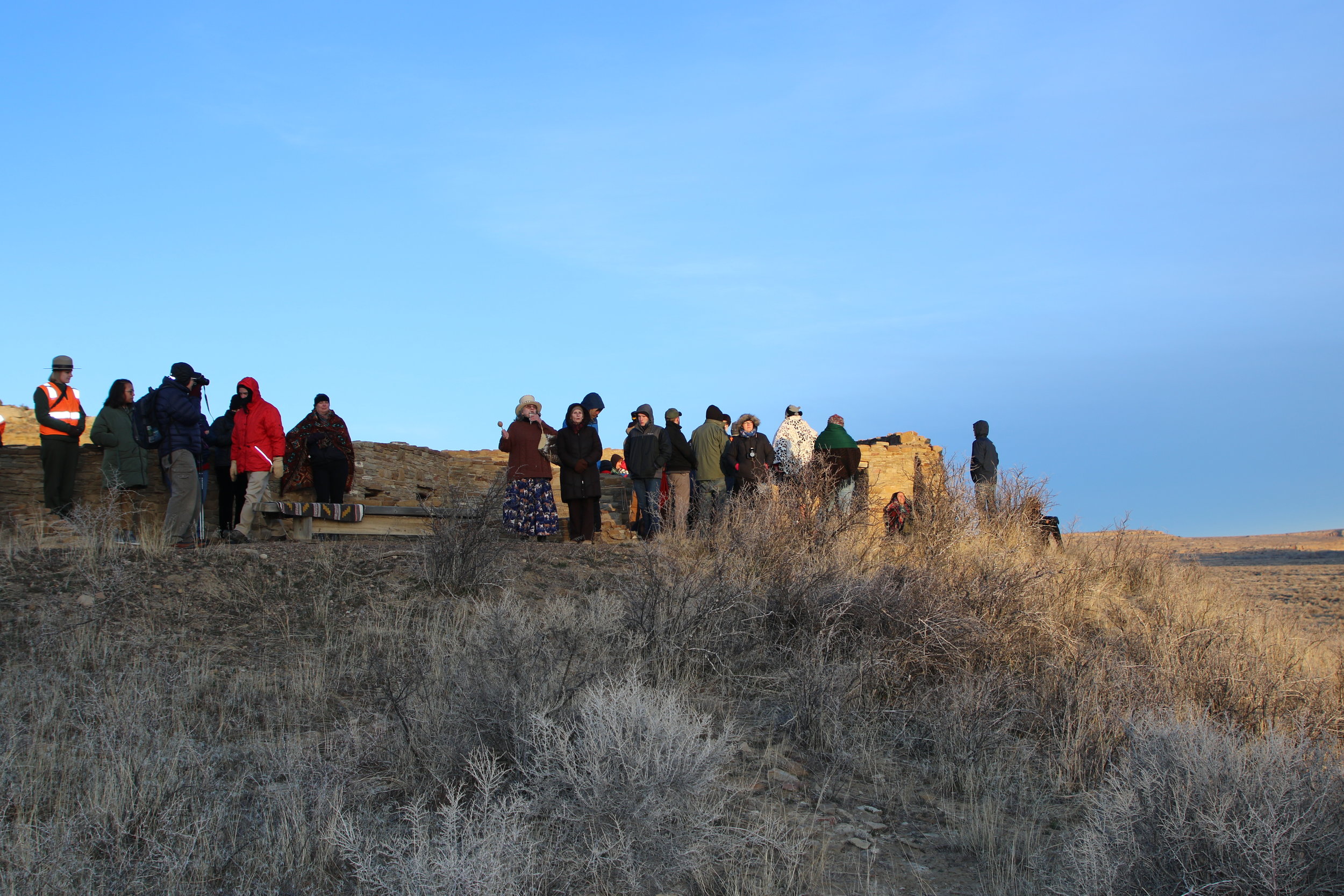With the arrival of the Summer Solstice, I've been thinking back to the Spring Equinox. We moved to New Mexico right around the Winter Solstice, in December. I had been wanting to see the Chaco Culture National Historical Park for a long time, so Soni and I decided to drive up for the Spring Equinox celebration in March.
Chaco Canyon was the center of trade and ceremony for the Anasazi peoples of the southwest from approximately 800-1200. The Chacoan people built amazing stone Great Houses of multiple stories with hundreds of rooms, as well as impressive kivas and other buildings. Some of the most impressive and well-known structures are located in Chaco Canyon itself, but hundreds more extend throughout the San Juan Basin and the Four Corners region, connected via an extensive network of roads.
As we would witness the morning of the Equinox, much of the architecture at Chaco Canyon is oriented around sun and moon cycles. During the Spring Equinox, as the sun gradually rises above the canyon walls, it shines directly through the cardinally-aligned windows of Casa Rinconada, the largest kiva in the canyon.
Today, the Greater Chaco landscape that surrounds the park remains a living landscape, and one that is sacred to many Indigenous communities throughout New Mexico. The area is home to primarily Diné (Navajo) communities living on the Eastern edges of the Navajo reservation in what is known as the Checkerboard – the patchwork of federal, tribal, state, and private land that extends outwards from the formal Chaco park boundaries. This landscape is increasingly threatened by the encroachment of oil and gas development, spurred by new fracking technologies. Oil and gas extraction in the Greater Chaco landscape is continuing at a steady pace despite the fact that the Navajo Nation, several Navajo Chapters, and the All Pueblo Council of Governors have all called for moratoriums on fracking in the area until the social and environmental impacts of this extraction are assessed.
Fajada Butte
We drove to Chaco in the afternoon, hoping to get there early enough to wander around before sunset. The roads to Chaco are notoriously difficult, with miles of dirt roads before the park entrance. When there is a lot of rain, it can be impossible to get through without 4-wheel drive. Since we had the driest winter in years in New Mexico, the roads were fine, but very dusty and bumpy, so we had to drive with care. After we turned off Highway 550 onto the road to Chaco, we drove through a lot of farmland, passing over a number of cattle guards on our way. The drive into Chaco Canyon is stunning. Fajada Butte stands out as the first distinguishable landmark, vast even from a distance.
Chetro Ketl
We pulled into the visitors’ center just as it was closing up for the day. A friendly park ranger told us that we should come back no later than 6am the next morning to line up for the Equinox celebration. We decided to make the most of the sun and drove further into the park before heading back to the campground near the entrance.
Petroglyphs near Chetro Ketl
The sun was beginning to get lower in the sky as we explored the ruins. The light was dramatic and the contrasting shadows made the buildings and the whole landscape seem more vibrant and alive.
Pueblo Bonito
Our lovely campsite
The campground was almost full with tents and campers, and a few large groups in tour vans there for the Spring Equinox celebration. When we found our campsite, I was delighted to see that it was next to the canyon wall. We pitched our tent and built a campfire. Leftover escarole stew and Soni’s oat bread was the perfect warming dinner as the temperature began to drop. Chaco Canyon is in the high desert, and gets warm during the day, but the temperatures plummet at night. We sat in our parkas and watched the fire burn as the sun set. On a normal night in Santa Fe, we can see the stars from our front porch. Which, coming from Chicago, is amazing. But the stars at night at Chaco Canyon are a whole other level of amazing. Chaco Culture National Historical Park is certified as an International Dark Sky Park. This means that over 99% of the park is a “natural darkness zone” with no permanent outdoor lights. With no lights to distract us or diminish the brightness of the night sky, the stars were dazzling.
We had packed pillows and an extra comforter just in case our sleeping bags weren’t warm enough, so we were extra cozy in our tent when we went to sleep. It was not quite enough though. We both woke up in the middle of the night to find ice on our sleeping bags and lining the inside of the tent. The temperature had dropped to around 20 degrees F. We put on extra sweaters and tried to stay warm until morning, which mostly meant that we didn’t sleep much. Other campers fared less well, and when we went to the bathroom, we found several ladies in their sleeping bags on the floor, huddled next to the space heater.
The moon at Chaco
Around 4 am, we began hearing the first of the non-campers driving in to start lining up at the gate.
Since we weren’t really sleeping, we got up at 5, made coffee and oatmeal in our parkas, and joined the other cars in the line up. We warmed up in the car as we ate our early morning breakfast.
At 6:30 am the gates to the main part of the park opened. We slowly followed the long line of cars proceeding to the parking lot near Casa Rinconada for the sunrise. We parked and waited for the rest of the crowd to arrive. To keep it from getting too crowded, the Park Service only lets the first 100 people at the gate into the park for the Spring Equinox celebration. While we waited to walk up the hill to Casa Rinconada, everyone stood there huddled in small clusters with cameras around their necks, some in parkas, some in blankets. Everyone was doing a little dance to stay warm.
Sunrise in the canyon
The head park ranger led the group on a short narrow path up to Casa Rinconada. The sky had begun to get brighter, but the sun wasn’t quite up yet. The ranger gave a brief explanation of the alignment event. He then instructed the crowd that anyone who wanted to get a photo of the alignment - the sun shining through the east and west windows of the kiva - should begin lining up behind the western window.
The line quickly increased to 30 or 40 people, and after standing there for a good fifteen minutes, I decided that I didn’t really need a perfect photo of the alignment. Also, even with a bit more light, it was still too cold to stand still for any length of time. Soni and I walked around the kiva, watched the sun slowly rise above the canyon, and watched the people watching the sunrise.
First light
The Spring Equinox crowd
Good morning Spring!
The first light that crept over the canyon wall was magical. It’s been ages since I’ve been outside watching the sunrise on purpose, and it felt like a nice, albeit strange, way to see Chaco Canyon for the first time. Seeing the sun set and the sun rise against the canyon walls is so different. The first rays of the sunrise that peek over the canyon walls are bright and strong and blinding, and then soften out as the light filters across the canyon. The night before, the sun had been blinding, and dramatic, before giving way to the soft light at the moonrise. We watched as the light filled the sky, and the line of picture takers progressed, and decided to say hello to the day with a hot cup of coffee at the visitors’ center.











